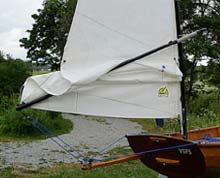| I sail an Apple 16 (www.campionboats.co.uk)
with a sprit-boomed mizzen sail of 5.4 sq m (= 58 sq ft) instead
of the standard balanced lug sail. I had a tapered bendy fiberglass
Zoom 8 dinghy mast, and decided to use a flat-topped sprit-boomed
sail with it, because this sail is easily flattened for strong
winds by tightening the snotter. I first had it sleeved, but the
inability to easily raise and lower it while sailing or reef it
led me to change to a track. I bought plastic track used to attach
a shade awning to the side of a camping trailer and sewed short
(25-40 mm = 1.75 in approx) lengths of the round plastic track
to the luff. The track for the awning is a flexible plastic rod
about 6 mm in diameter, and it has a woven fiberglass cover that
forms a flange along the rod for sewing to the awning.
I sewed the longer bits (40mm) at the top and bottom and on
either side of the plastic batten luff inserts for better support.
The reefing methods described for a sprit-boomed sail had disadvantages.
The traditional method of using a line run from top to bottom
through grommets behind the luff was unappealing because of the
turbulence the bunched-up sail would create behind the mast. The
method of using loops of rope or webbing at the clew and the leech
reef point and shifting the aft end of the sprit up when reefing
also was out because I did not want to be pulling down a flapping
sail and then pulling inboard the clew and moving the snotter
and then brailing up the redundant bottom part of the sail, while
the boat was jumping around in the conditions that require reefing.
Particularly as the clew of the mizzen is 5 feet behind the transom.
So I used a slight modification of the standard method of slab
reefing that I use on the mainsail, which I have not found described
for a sprit-boomed sail. Slab reefing is fast, can be done without
totally lowering the sail, and minimally disturbs the airflow
as the bunched sail is parallel to it.
|
Reefing diagram. Click for larger pdf image. |
The diagram (1.) above shows the way the luff and clew reefing
lines are attached and run. I first measured a rectangle whose
reference points for placement of grommets were: (1), where the
reef grommet was to be placed on the leech about 3 feet above
the boom to reduce the sail area to about 3 sq m, (2) on a vertical
from (1), just above where the boom crossed the clew, (3), horizontal
to (1) at the luff, (4), horizontal to (2) at the luff. The luff
line is first fastened to the side of the mast through a small
stainless saddle and a knot, above grommet (4) at the luff. It
then runs down and through this grommet, up and through grommet
(3) at the luff, and down to a cleat on the mast at a convenient
height. When tightened, it pulls the bottom of the luff up and
the top down, keeping the luff tight. The clew line is first hitched
to the boom at the grommet (2), runs through it and up to grommet
(1) at the leech, down and back and through a small block tied
to a short line that is fastened to the end of the boom, and forward
to a clamcleat on the boom.
 |
Reefed |
The photos show the luff (2.) and leech lines (3.) and the whole
sail (3.) reefed. I use 4 or 5 mm Dyneema line for reefing and
other small lines to trim the sails. The last photo (4.) shows
the reefed sail in action, with a line through grommets in the
middle of the sail and the reefing grommets to brail the loose
folds together, which is not strictly necessary. I can easily
reef the sail from the cockpit which is necessary because the
mizzen sticks so far back over the transom.

***** |

